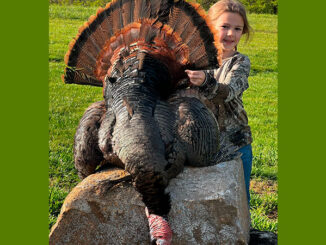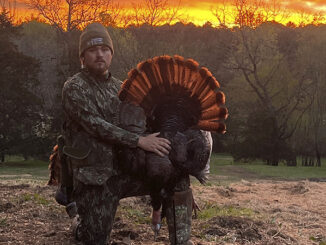
Smallmouths are bigger-stream bruisers
Western North Carolina streams may be best known for trout, but many of the larger ones offer another excellent and often overlooked fishery: smallmouth bass. When it comes to action, few fish can match the fighting ability of a smallmouth, and to hook one using light spinning tackle or a fly rod has to be the angling equivalent of paradise.
The best smallmouth streams are the Tuckasegee River in Jackson and Swain counties, the Little Tennessee River in Macon and Swain, the French Broad River in Buncombe and Madison, the North Toe, South Toe, and Toe rivers in Avery, Mitchell, and Yancey, the Nolichucky on the Mitchell-Yancey line, and the New River in Ashe and Alleghany.
Best fishing times are early morning and late evening. Best fishing conditions are when the water is clear to slightly dingy and low. Most river smallmouth average two to three pounds, but it’s not unusual to hook a 4-pound smallmouth, especially in the larger rivers.
Depending on skill level and fishing preference, either spinning tackle or fly-rods can be used. For spinner fishing, ultralight to medium-light spinning rods and clear 4- to 8-pound test line provide the best action. Light lures generally work best, and variety is the key: topwater and diving plugs, spoons, spinners, small plastic worms and grubs.
For fly-fishing, a 6- to 8-weight rod is recommended. For topwater fishing, a 7-foot or 9-foot leader works well. For sub-surface, a 2- or 3-foot leader gets best results.
Drift boats, johnboats, small rafts, canoes — anything that will float a river — can be used. In larger rivers, such as the French Broad, Tuckasegee, and Little Tennessee, some fishers use small outboard motors, but in late spring and early summer, streams often are too shallow to safely use a motor.
Jeff Furman of Davidson River Outfitters in Brevard (www.davidsonflyfishing.com), guides float trips on the French Broad River from the Asheville airport to Hot Springs in Madison County.
His standard lures are Nos. 8-4 Boogle Bug in white, black, orange, yellow or chartreuse; Nos. 6-2 olive or white Clouser minnow and a No. 4 Big Nasty (a hellgrammite pattern). Another favorite fly is called the Meat Whistle, a large streamer tied to a jig hook. The key, he said, is to use a variety of lures and colors until you find something that works and stay with it.
He often uses popping bugs but prefers to fish them drag-free instead of popping them on the surface. Furman looks for structure such as rocks, woody debris, logs, overhung banks and grass ledges. Also, he said, don’t overlook stretches of quiet water, such as eddies and pocket pools.
Matt Canter of Brookings’ Anglers in Cashiers (www.brookingsonline.com) guides on the French Broad River starting below the airport, the Needmore section of Little Tennessee River in Macon County and the Tuckasegee River from Dillsboro to Fontana Reservoir.
His preferred lures are No. 1 Kraft Minnow in white or chartreuse, Nos. 6-2 Clouser Minnow and a No. 2 JJ Special, a brown woolly worm pattern with yellow rubber legs.
“Smallmouth are ambush fish,” he said. “They wait for prey behind rocks or logs. I tell my clients to fish for smallmouth where trout would not be.”
Canter likes to “smack” a fly on the surface as if it’s a bug falling into the water.
Chris Manderson of Asheville (www.whitewatersportsman.com) guides on the lower French Broad River, putting in at Woodfin, just north of the Asheville city limits. This section of the river is loaded with smallmouth, he said. If he catches only 15 to 20 smallmouth, he considers it a poor day of fishing. A good day for him is 50 to 100 smallmouth, and he has many more good days than bad. Frequently, the daily catch includes a smallmouth up to four pounds. “That’s a big fish for the river,” Manderson said.
Most of Manderson’s guided trips are spinner fishing with small lures, crankbaits and buzzbaits. “It can change day by day,” he said, so he experiments until he finds the right combination. In clear-water conditions, Manderson prefers gold and silver lures. When the water is dingy, he switches to brightly colored lures.
The key to river fishing, Manderson said, is to keep moving and to be aware of river conditions. “You have to move fast enough to keep off rocks, but slow enough to fish effectively.”
Unlike lake fishing, Manderson said, river fishing depends heavily on water conditions. When the water is high and currents are swift, it’s not a good time to be on the river. Nor is fishing productive after a hard rain or thunderstorm. The river muddies up quickly, and good fishing ends. Ideal conditions are when the river is slightly dingy and low.
Manderson said there’s usually a lull from late August through September, “but fall fishing is very good, usually through the middle of November.”
The very best fall fishing is in October. “Then you have a feeding frenzy,” he said.
Because most smallmouth streams are designated trout waters, fishers are required to have a comprehensive fishing license. Creel and size limit are the same as in western North Carolina lakes: five smallmouth, 12 inches minimum.




